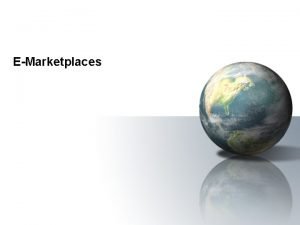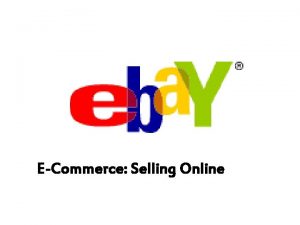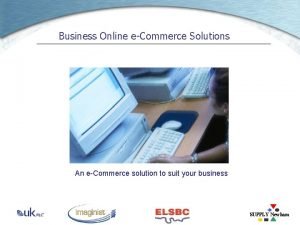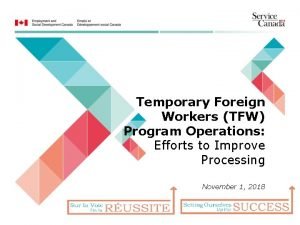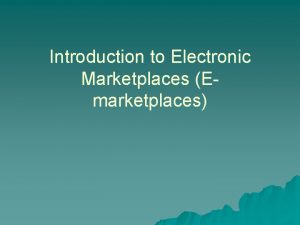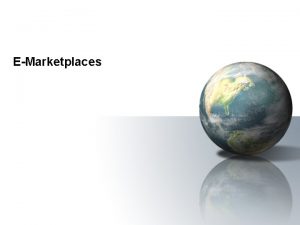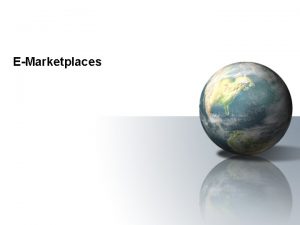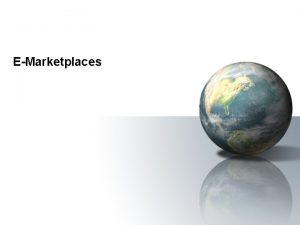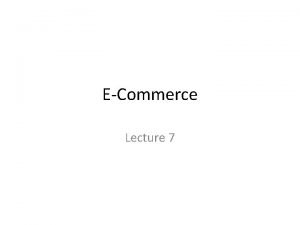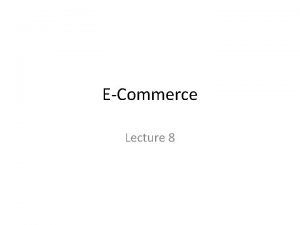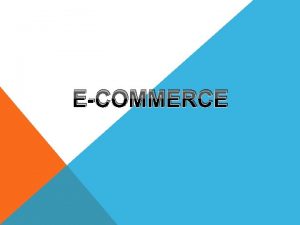ECommerce Lecture 6 EMarketplaces An online market usually










- Slides: 10

E-Commerce Lecture 6

E-Marketplaces • An online market, usually B 2 B, in which buyers and sellers exchange goods or services; • Marketspace – A marketplace in which sellers and buyers exchange goods and services for money (or for other goods and services) but do so electronically

E-marketplaces • Markets (electronic or otherwise) have three main functions – Matching buyers and sellers – facilitating the exchange of information, goods, services and payments associated with market transactions – providing an institutional infrastructure, such as a legal and regulatory framework that enables the efficient functioning of the market

E-Marketplace Components and Participants • Customer – the people worldwide who surf the web are potential buyers of the goods and services offered or advertised on the internet. Organizations are the largest consumers, accounting for more then 85% of EC activities.

E-Marketplace Components and Participants • Sellers – Millions of the storefronts are on the web, advertising and offering a huge variety of items. these stores are owned by companies, government agencies, or individuals. Sellers can sell direct from their websites or from emarketplaces.

E-Marketplace Components and Participants • Products and Services – One of the major differences between the marketplace and the marketspace is the possible digitization of products and services in marketspace. Although both types of market can sell physical products the market space also can sell digital products, which are goods that can be transformed to digital format and instantly delivered over the internet.

E-Marketplace Components and Participants • Infrastructure – the marketspace infrastructure includes electronic networks, hardware, software and more.

E-Marketplace Components and Participants • Front End – Customers interact with a marketspace via a front end. The components of the front end can include the seller's portal, electronic catalogs, a shopping cart, a search engine, an auction engine, and a payment gateway.

E-Marketplace Components and Participants • Back End – All the activities that are related to order aggregation and fulfillment, inventory management, purchasing from suppliers, accounting and finance, insurance, payment processing, packaging and delivery are done in what is termed the back end of the business.

E-Marketplace Components and Participants • Intermediaries – In marketing, an intermediary is typically a third party that operates between sellers and buyers. • Other Business Partners – In addition to intermediaries, several types of partners such as shippers , use the internet to collaborate, mostly along the supply chain. • Support Services – Many different support services are available, ranging from certification and escrow services to content providers.
 Emarketplaces
Emarketplaces What are
What are 01:640:244 lecture notes - lecture 15: plat, idah, farad
01:640:244 lecture notes - lecture 15: plat, idah, farad Market leader market challenger market follower
Market leader market challenger market follower Difference between segmentation targeting and positioning
Difference between segmentation targeting and positioning Ecommerce online auctions
Ecommerce online auctions Online ecommerce solutions
Online ecommerce solutions Online lecture
Online lecture Lmia online pilot
Lmia online pilot Teaching market structures with a competitive gum market
Teaching market structures with a competitive gum market Primary target market and secondary target market
Primary target market and secondary target market
